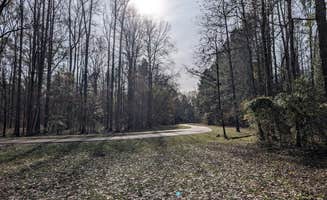Primitive camping near Brookhaven, Mississippi centers primarily around the Natchez Trace Parkway, a 444-mile scenic route managed by the National Park Service. The surrounding mixed hardwood forests provide natural shade with oak, hickory and pine trees common throughout the region. Summer temperatures regularly exceed 90°F with high humidity, while winter nights can drop below freezing, affecting camping comfort and preparation needs.
What to do
Explore historic sites: The Rocky Springs area includes abandoned town ruins and a 19th-century church within walking distance of the campground. "Walked the loop (about 0.6 miles) several times a day. Our site was about 80 yards from the toilet. Lots of trails through the middle of the loop as a shortcut to the toilet," notes camper Kevin C.
Stargazing opportunities: Limited light pollution makes the area ideal for astronomy enthusiasts. "We picked a pull-thru site and lit a fire in the ring and used our own camp chairs and table for a lovely star filled night," reports camper Darlene about her experience at Rocky Springs.
Hiking trails: The surrounding forests offer moderate terrain suitable for day hikes. Pack adequate water as drinking sources are limited throughout the trail system, especially during summer months when creek beds may run dry.
What campers like
Privacy between sites: Caston Creek WMA provides more secluded primitive camping with natural vegetation creating separation between camping areas. Management focuses on wildlife habitat rather than camping amenities.
Night sounds: The dense forest creates an immersive natural soundscape, particularly at dawn and dusk when wildlife activity peaks. Spring and fall migration periods bring additional bird species through the area.
Self-sufficient setting: The primitive nature appeals to experienced campers seeking minimal infrastructure. "It is a terrific spot to stop and sleep," according to Erich H., referring to Natchez Trace Parkway camping.
What you should know
Weather considerations: Summer thunderstorms develop quickly in this region, particularly during afternoon hours. Lightning risks increase from April through September, requiring vigilance and weather monitoring.
Limited supplies: No stores exist within the immediate camping areas. The nearest reliable supply points are in Brookhaven, approximately 30 minutes from most dispersed camping locations. Stock up before arrival.
Cell service gaps: Coverage varies significantly by carrier throughout the region. One Rocky Springs visitor noted: "I drove through. The sites are level, clean and about half a pull through. Each site has a picnik bench fire pit. However, I did not stay because it had absolutely no Tmobile cell service and being alone and full time. I did not feel like camping without it."
Tips for camping with families
Safety planning: With limited emergency services and communication, establish meeting points and emergency procedures before separating within the camping area. Children should carry whistles and understand basic navigation.
Wildlife education: The region hosts numerous snake species including venomous varieties. Teach children proper footwear requirements and to check shoes before putting them on. Store food properly to avoid attracting raccoons and other scavengers.
Bathroom access: Bathroom facilities at primitive sites may be basic or nonexistent. Bring portable toilet options for young children, particularly for nighttime needs when walking to facilities is impractical.
Tips from RVers
Road conditions: The narrow access roads leading to primitive camping areas near Brookhaven require careful navigation with larger vehicles. "Nice primitive grounds with pull-through and back-in options," reports Erich H. about his experience bringing a fifth-wheel to Rocky Springs.
Leveling requirements: Natural terrain means uneven parking surfaces at most primitive sites. Bring adequate leveling blocks as many sites feature subtle slopes that become noticeable in larger vehicles.
Generator policies: Confirm current generator usage rules before arrival as they vary by location and season. Some areas restrict hours while others prohibit generators entirely, requiring self-contained power solutions.


